
Changing Steel Strings
There are as many variations on the process of changing steel strings as there are players, and not all methods are equally effective. Some interfere with tuning (too many wraps), while others make strings susceptible to breakage (too few wraps). Developed over decades of experience, the current Taylor Guitars method has proven to provide outstanding results for all steel-string guitars.
Position yourself comfortably to change strings. A workbench is ideal; sitting on a sofa and resting the neck of the guitar on the sofa arm is another viable option. Loosen the bass strings - 6th (Low E), 5th (A), and 4th (D) - by turning the tuners clockwise with your left hand while holding tension on the string with your right hand. Loosen the treble strings - 3rd (G), 2nd (B), and 1st (High E) - by turning the tuners in a clockwise direction.
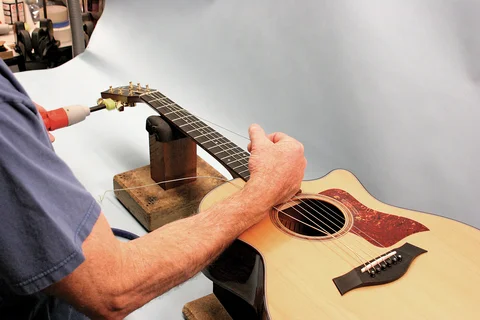
When all the strings are loosened, use wire cutters to remove the bridge pins. Using the saddle as a cantilever, exert gentle pressure to pull out the bridge pins. Now, gently lift out the old strings from the bridge and discard them. With the old strings literally out of the way, you have a great opportunity to clean your fretboard. Cover the guitar's soundhole with a towel and clean the fretboard with .0000 gauge steel wool. You can rub pretty hard without damaging the fretboard, but be careful not to let it touch the body! This is also a good time to add a little fretboard conditioning oil if it’s looking dry. We suggest using our Taylor Fretboard Oil or boiled linseed oil. A small amount poured on to a rag and wiped over the wood is all it takes. Once your fretboard is clean, it’s time to re-string.
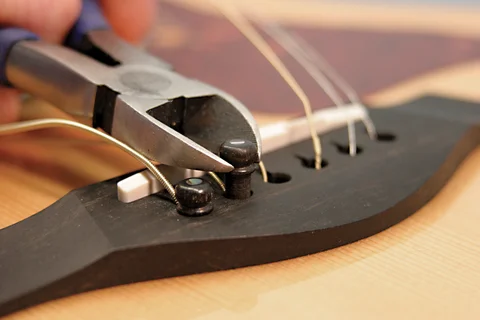
Once your fretboard is clean, it's time to re-string. Begin by inserting the ball end of the 6th string, followed by the bridge pin. Push the bridge pin down and pull up on the ball end until it catches. Pull gently on the string to verify that it's "locked" in place.
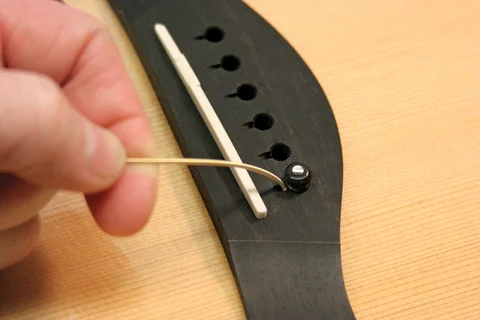
Stretch the 6th string over the peghead. Using wire cutters, trim the string at the 5th string post.

Turn the 6th string tuner so the hole in the tuner is at a 45-degree angle, then insert the 6th string and turn the tuner in a counter-clockwise direction to tighten the string. The string end should protrude approximately 1/8th of an inch from the tuner hole.
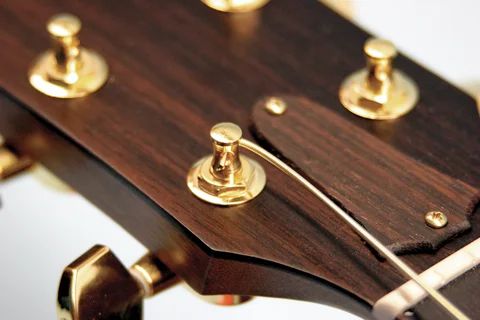
Tune the string to pitch. Two to three wraps is perfect for the bass strings. More is not better. Repeat the procedure to install the 5th string. As with the other bass strings, you will stretch the string the equivalent of one tuner length past the post into which it's inserted.

For the 4th string, simply measure one tuner length of slack before snipping the string and tightening.
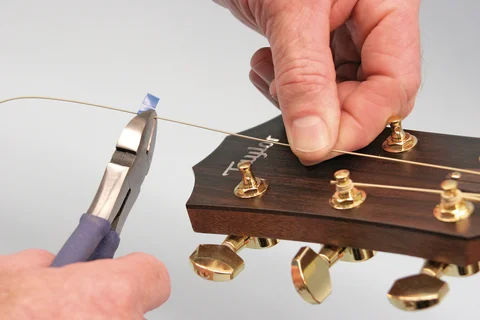
Trim the treble string ends 1-1/2 tuner lengths past the post into which it's inserted. For the 3rd string, as well as for the other treble strings, the hole in the tuner should be at a 45-degree angle, as shown. Tighten the treble strings in a counter-clockwise direction.
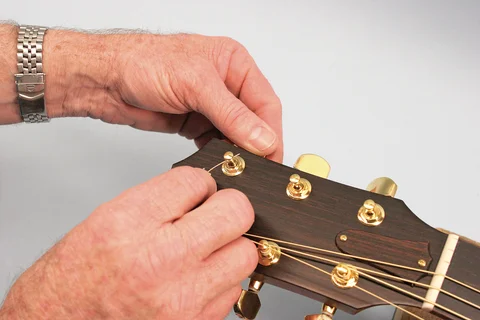
The treble strings (G, B, and High E) require approximately six wraps.
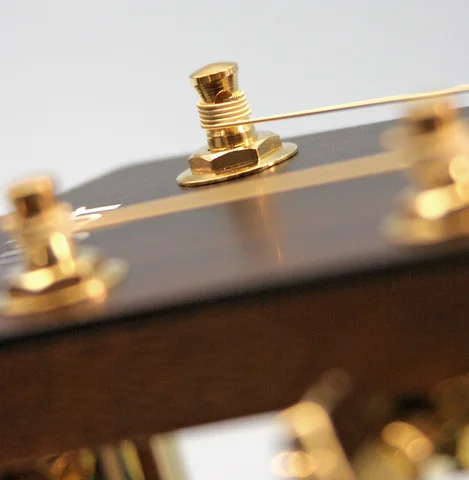
Keep the bottom-most wraps of the treble strings below the edge of the tuner holes to avoid creating a kink, which could break the string.
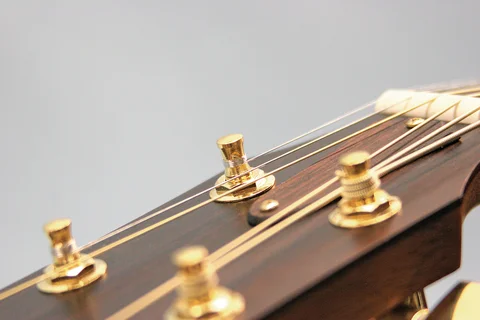
Gently stretch each string several times until the string stays in pitch. Tune your guitar and you're ready to play!
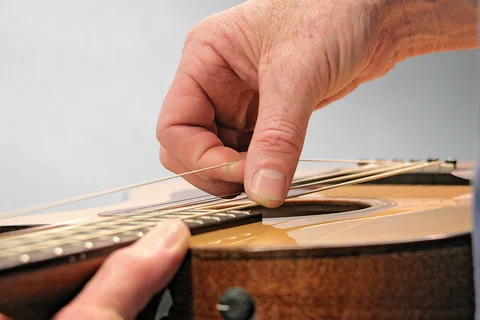
The stringing process is the same for 12-string guitars, except that you should trim the bass strings the equivalent of two tuner lengths past the post into which it's inserted and three tuner lengths for the trebles.
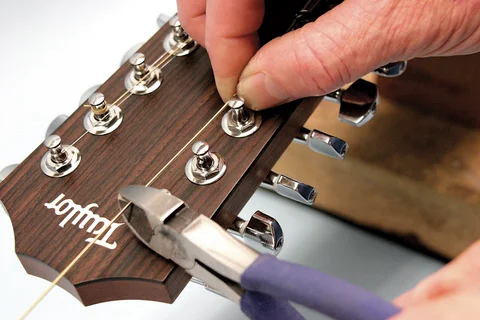
When re-stringing a slot-head guitar, trim the strings one and one-half tuner lengths past the post.
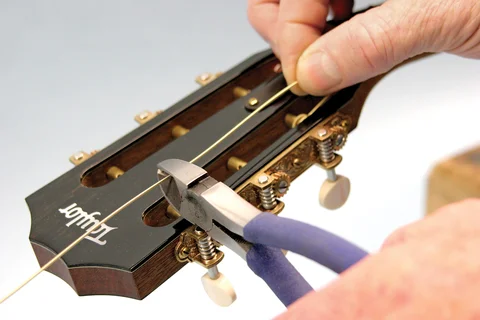
Position the tuner hole as shown and insert the string.
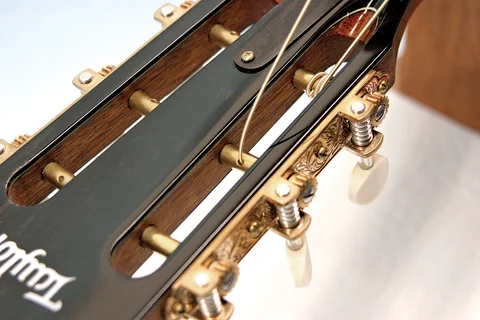
Here's the big difference: One wrap goes on the inside; the rest of the wraps go on the outside of the string end, toward the tuners.
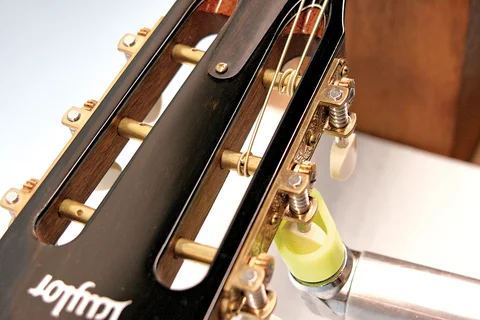
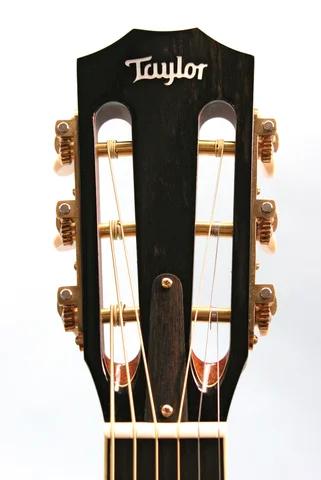
Customer Service
1-800-943-6782
Monday - Friday
8:00 a.m. - 4:30 p.m. PST
Our El Cajon, California and Amsterdam, the Netherlands Factory Service Center staff can help with any service, maintenance or repair questions concerning Taylor guitars.
+31 (0)20 667 6033
Monday - Friday
8:00 a.m. - 4:30 p.m. (CET)
1-800-943-6782
Monday - Friday
8:00 a.m. - 4:30 p.m. PST
International






















